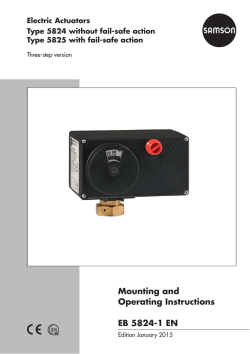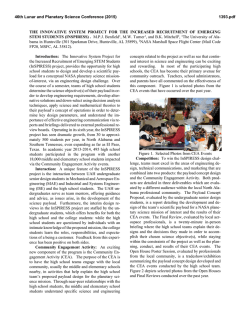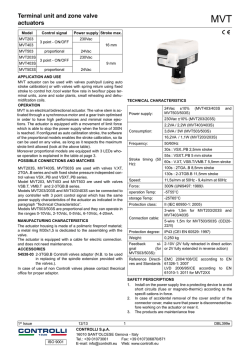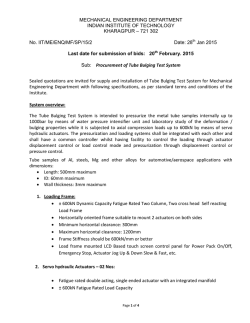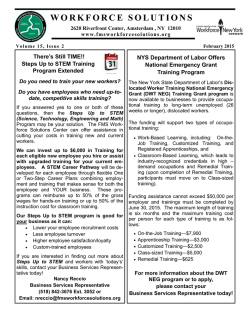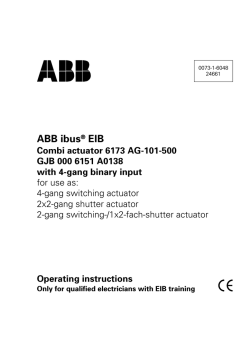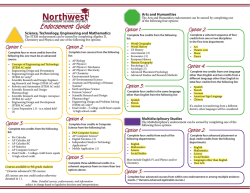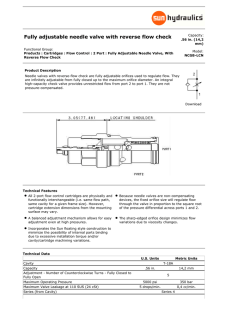
Masoneilan 87/88 Series Spring Diaphragm Actuator Instructions
Instruction ER8788 06/97 Masoneilan 87/88 Series Spring Diaphragm Actuator Instructions For complete listing of parts refer to Masoneilan publication FR8788 Instruction ER8788 06/97 87/88 Actuator TABLE OF CONTENTS 8. Actuator Range . . . . . . . . . . . . . . . . . . . .7 - 8 1. Introduction . . . . . . . . . . . . . . . . . . . . . . . . . . .2 2. General . . . . . . . . . . . . . . . . . . . . . . . . . . . . . .2 3. Actuator Description . . . . . . . . . . . . . . . . . . . .2 9. Air Action Changes . . . . . . . . . . . . . . . .8 - 10 4. Unpacking . . . . . . . . . . . . . . . . . . . . . . . . . . . .2 10. 5. Air Piping . . . . . . . . . . . . . . . . . . . . . . . . . . . . .2 Actuator Installation on Valve Body and Plug stem Adjustments . . . . . . . . .10 - 11 6. Actuator Removal . . . . . . . . . . . . . . . . . . .3 - 4 Parts Reference . . . . . . . . . . . . . . . . . . . . .12 7. Maintenance . . . . . . . . . . . . . . . . . . . . . . .4 - 7 Table 4 . . . . . . . . . . . . . . . . . . . . . . . . . . . . .13 Tables 1, 2, 3 . . . . . . . . . . . . . . . . . . . . . . . . .7 The following instructions should be thoroughly reviewed and understood prior to installing, operating or performing maintenance on this equipment. Throughout the text, safety and/or caution notes will appear and must be adhered to strictly; otherwise, serious injury or equipment malfunction could result. 1st Digit 2nd 8 Actuator Type 87 88 Air to Close (extend stem) Air to Open (retract stem) 1. INTRODUCTION 3. ACTUATOR DESCRIPTION The following instructions are designed to assist maintenance personnel in performing most of the maintenance required on the Model 87/88 actuator. Masoneilan has highly skilled service engineers available for start-up, maintenance and repair of our actuators and component parts. In addition, a regularly scheduled training program is conducted at the Training Center, to train customer service and instrumentation personnel in the operation, maintenance and application of our control valves and instruments. Arrangements for these services can be made through your Masoneilan Representative or Sales Office. When performing maintenance, use only Masoneilan replacement parts. Parts are obtainable through your local Masoneilan Representative or Sales Office. When ordering parts, always include Model and Serial Number of the unit being repaired. The 87/88 Series are pneumatic spring diaphragm actuators which feature field reversibility (with no additional parts). Because of its multiple spring design, four standard spring ranges are achieved by varying spring quantity and placement. A molded rolling diaphragm and deep cases minimize area change, effecting a linear relationship between travel and air pressure. Caution: For full automatic operation, the handwheel must be placed in the neutral position. If the handwheel is not in the neutral position, travel will be limited. 4. UNPACKING Care must be exercised when unpacking the equipment to prevent damage to the accessories and component parts. Should any problems arise, contact your Masoneilan Representative or District Office. 2. GENERAL 5. AIR PIPING These installation and maintenance instructions apply to the Masoneilan Model 87/88 actuator regardless of the valve body on which it is used. Actuator part numbers and recommended spare parts required for maintenance are listed in the Part Reference Table on page 12. The model number and action of the actuator are shown as part of the model number listed on the identification tag located on the actuator. © 1997 Dresser Industries, Inc. All rights reserved. The Model 87/88 actuator is designed to accept 1/4" NPT air supply connections. If the actuator has been supplied with accessories, they are piped at the factory. Caution: Do not exceed pressure indicated on identification tag. 2 Instruction ER8788 06/97 87/88 Actuator 6. ACTUATOR REMOVAL 6.3 Air to open (Model 88), size 6, no handwheel (Figures 2 and 4) Maintenance on the valve body normally requires removal of the valve actuator. The steps in removal of the actuator are different depending on whether the actuator is air to close or air to open. Since removal of the valve plug stem from the actuator stem connector requires that the valve plug be off the seat, special provisions are necessary to assure that the valve is in the opened position. The actuator do not being equipped with a handwheel, proceed as follows: Note: Actuator action may be checked by referring to the valve identification tag. Model 87 indicates unit is air to close and Model 88 indicates unit is air to open. Note: Since air supply piping connected to the actuator is normally rigid and the actuator will be moved, it is required that a manual loading panel with suitable flex tubing be used or some suitable type of flex connections be made between the supply piping and the actuator connection. 6.1 Air to close (Model 87), size 6, with or without handwheel (Figure 2) A. Shut off air supply to actuator and rotate handwheel to the neutral position. [No force exerted on the stem connector by the pivot pins (33)]. Caution: Unreasonably high stress placed on rigid piping could cause breaking of the air supply line. A flex connector is required. B. Disconnect air piping from diaphragm case. C. Check the travel indicator (7) against the travel scale (9) to insure that the plug is up (off the seat). A. Shut off air supply to the actuator. B. Disconnect air supply piping to the actuator. Note: No air pressure is required to the actuator since the spring pressure tends to open the valve. D. Loosen stem lock nuts (1). C. Connect manual loading panel tubing to the lower diaphragm case tubing connector. E. Re-tighten lock nuts (1) against each other so they will lock at a point that is not against the stem connector (2). D. Apply required air pressure through the manual loading panel to open the valve as is indicated by the travel indicator (7) and travel indicator scale (9). Caution: Do not exceed pressure indicated on the tag (63) on the diaphragm case. Caution: At this time provisions must be made to support and lift the actuator off the body using recommended lift supports and procedures. E. Loosen stem lock nuts (1). F. Loosen and remove drive nut. F. Re-tighten stem lock nuts (1) against each other so they will lock at a point that is not against the actuator stem connector (2). Caution: Depending on stem length, it may be required to slightly raise the actuator off the body to enable the plug stem to disengage from the actuator stem. The actuator must be raised straight off the body to prevent stress on the plug stem. Caution: At this time provisions must be made to support and lift the actuator off the body using recommended lift supports and procedures. G. Turn the stem lock nut (1) counterclockwise and loosen the plug stem until it disengages from the actuator stem (10). G. Loosen and remove drive nut. Caution: Depending on stem length, it may be required to slightly raise the actuator off the body to enable the plug stem to disengage from the actuator stem. The actuator must be raised straight off the body to prevent stress on the plug stem. Note: Do not allow the valve plug to drop or turn against the seat ring, as this could damage the seat and plug. H. Remove actuator from the valve body. H. Turn the upper stem lock nut (1) counterclockwise and unscrew the valve plug stem until disengaged from the actuator stem (10). Caution: Care should be taken in handling the actuator to prevent damage to gauges, tubing, and component parts. Note: Do not allow the plug to drop or turn against the seat ring. This could damage the seat and plug. I. Remove actuator from the valve body and shut off air supply pressure. 6.2 Air to open, Model 88, size 6, with handwheel Caution: The stem connector (2) on this size is not fixed to the actuator stem and is a loose part with the plug stem removed. For safety, the handwheel must be in a free position and the actuator removed from the valve using procedure 6.3 Air to Open without handwheel. Caution: Care should be taken in handling the actuator to prevent damage to gauges, tubing, and component parts. In addition, since a flex connection is made between the actuator and air piping, care must be taken not to exert pressure on the flex tubing or air piping. 3 Instruction ER8788 06/97 87/88 Actuator E. Loosen stem lock nuts (1). 6.4 Air to close (Model 87), sizes 10-23, with and without handwheel (Figure 3) F. Remove cap screws (5) from stem connector (2, 4). A. Shut off air supply to actuator and rotate handwheel to the neutral position. Note: Do not allow the valve plug to drop or turn against the seat ring, as this could damage the seat and plug. B. Disconnect air piping from diaphragm case. C. Check the travel indicator (7) against the travel scale (9) to insure that the plug is up (off the seat). Caution: At this time provisions must be made to support and lift the actuator off the body using recommended lift supports and procedures. Note: No air pressure is required to the actuator since the spring pressure tends to open the valve. G. Loosen and remove drive nut. D. Loosen stem lock nut (1). E. Remove cap screws (5) from stem connector (2, 4). Caution: Progressively raise actuator off the body to enable the top stem connector (4) disengage the bottom stem connector (2). The actuator must be raised straight off the body to prevent stress on the plug stem. Note: Do not allow the valve plug to drop or turn against the seat ring, as this could damage the seat and plug. Caution: At this time provisions must be made to support and lift the actuator off the body using recommended lift supports and procedures. H. Remove bottom stem connector parts (1, 2, 6) from plug stem. I. Remove actuator from the valve and shut off air supply pressure. F. Loosen and remove drive nut. Caution: Progressively raise actuator off the body to enable the top stem connector (4) disengage the bottom stem connector (2). The actuator must be raised straight off the body to prevent stress on the plug stem. 7. MAINTENANCE Caution: It is recommended that disassembly or assembly work on these actuators be done in an upright position. G. Remove bottom stem connector parts (1, 2, 6) from plug stem. H. Remove actuator from the valve. 7.1 Replacing diaphragm air to open actuators (Model 88) with or without handwheel (Figure 4) 6.5 Air to open, Model 88, Size 10-23, with or without handwheel (Figure 4) A. Shut off air supply to the actuator, isolate the control valve process pressure to eliminate the valve from moving with spring tension removed. Since removal of the valve plug stem from the actuator stem connector requires that the valve plug be off the seat, special provisions are necessary to assure that the valve is in the opened position. Proceed as follows: B. If valve is equipped with a handwheel, rotate handwheel to a neutral position. Note: Since air supply piping connected to the actuator is normally rigid and the actuator will be moved, it is required that a manual loading panel with suitable flex tubing be used or some suitable type of flex connections be made between the supply piping and the actuator connection. C. Remove diaphragm case cap screws and nuts (20 and 19). Caution: Diaphragm case is under spring tension and is equipped with tension bolts (27, 28 and 56) which must be removed last. Caution: Unreasonably high stress placed on rigid piping could cause breaking of the air supply line. A flex connector is required. D. Remove tension bolts (27, 28 and 56) in multiple steps to relieve spring tension gradually. Remove upper diaphragm case (24). A. Shut off air supply to the actuator and rotate handwheel to the neutral position. E. Note position of springs (21) and spring spacers (18) [if equipped] in the diaphragm plate (26), before to remove these parts. B. Disconnect air supply piping to the actuator. C. Connect manual loading panel tubing to the lower diaphragm case tubing connector. F. Remove cap screw (23) [size 6] or jam nut (23) [all other sizes] and diaphragm washer (22) [all sizes]. D. Apply required air pressure through the manual loading panel to open the valve as is indicated by the travel indicator (7) and stroke scale (9). G. Remove diaphragm plate (26) and diaphragm (25). H. Replace the new diaphragm (25) on the diaphragm plate (26). Caution: Do not exceed pressure indicated on the tag (63) on the diaphragm case. I. Size 6 actuator coat the threads of cap screw (23) and 4 Instruction ER8788 06/97 87/88 Actuator mounted through the yoke and secure the handwheel pivot (36) in place (see Figure 7). D. Let the complete handwheel assembly swing down and out of the way of the top stem connector (4) [bottom stem connector (2) on size 6 actuator]. E. Proceed with the instructions for air to close actuators without handwheel (7.3). 7.3 Replacing diaphragm air to close (Model 87) actuator without handwheel (Figures 2 or 3 and 7) A. Shut off air supply to the actuator and remove air piping from the upper diaphragm case (24). B. Remove the two socket head cap screws (5) which hold the top and bottom stem connector (2 and 4) together. Figure 1 J. Checking placement of spacer (14), reassemble diaphragm (25), diaphragm plate (26), washer (22) then tighten fastener (23) in proper locations. Note: The size 6 actuator only has a bottom stem connector. For diaphragm replacement, the stem lock nuts (1) must be loosened. The plug stem is turned out at the actuator stem (10) in order to allow the actuator stem to rise with release of spring tension. Depending on stem length, it may be required, to allow this step, to separate the size 6 actuator off the valve body, as indicated in Section 6.1. K. Position springs (21) and spring spacers (18) [if used] in the diaphragm plate. C. Remove diaphragm case cap screws and nuts (20 and 19). the surfaces of washer (22) with Dupont Sealant Compound III or equal. All other sizes, coat the actuator stem threads (10) and the surfaces of washer (22) with Dupont Sealant Compound III or equal. Note: Arrange springs so that the coil ends are pointed toward the actuator stem as shown in Figure 1. This step assures best actuator performance. Caution: Diaphragm case is under spring tension and is equipped with tension bolts (27, 28 and 56) which must be removed last. L. Replace upper diaphragm case (24) and tension bolts (27, 28 and 56). Note: Tension bolts should be spaced equally around the bolt circle of the case. D. Remove tension bolts (27, 28 and 56) in multiple steps to relieve spring tension gradually. Remove upper diaphragm case (24). M. Tighten the tension bolts (27, 28 and 56) in equal steps until the cases meet. Replace the remaining cap screws (20) and nuts (19). E. Remove cap screw (23) [size 6] or jam nut (23) [all other sizes] and diaphragm washer (22) [all sizes]. F. Replace new diaphragm (25) on the diaphragm plate (26). Caution: Tighten cap screws and nuts evenly. Do not over-tighten as this could possibly warp the diaphragm cases. See Table 3 for torque values. G. Size 6 actuator, coat the threads of cap screw (23) and the surfaces of washer (22) with Dupont Sealant Compound III or equal. All other sizes, coat the actuator stem threads (10) and the surfaces of washer (22) with Dupont Sealant Compound III or its equivalent. Install washer (22) and tighten fastener (23). N. If so equipped, rotate handwheel to the desired position. 7.2 Replacing diaphragm air to close (Model 87) actuator with handwheel (Figures 2 or 3 and 7) H. Replace upper diaphragm case (24) and tension bolts (27, 28 and 56). Caution: The handwheel assembly can hold spring tension in the actuator when the diaphragm case is removed. To prevent possible injury, remove handwheel per the following procedure. Note: Tension bolts should be spaced equally around the bolt circle of the case. I. Tighten the tension bolts (27, 28 and 56) in equal steps until the cases meet. Replace the remaining cap screws (20) and nuts (19). A. Shut off air supply to the actuator, isolate the control process pressure to eliminate the valve plug from moving with spring tension removed. Caution: Tighten cap screws and nuts evenly. Do not overtighten as this could possibly warp the diaphragm cases. See Table 3 for torque values. B. Rotate the handwheel (41) to a neutral position. C. Remove two handwheel pivot pins (33) which are 5 Instruction ER8788 06/97 87/88 Actuator E. Remove cap screw (38) and end flange (37). This will release the bearing (34). J. Position top and bottom stem connectors (2 and 4) and replace the two socket head cap screws (5) and recalibrate the seated position of the valve (Section 10.2). F. Replace or clean to repack the bearing with new grease. Note: Size 6 actuator - Screw the plug stem back into the actuator stem (10) thru the bottom stem connector and recalibrate the seated position of the valve. If the actuator has been removed from the valve body, reinstall it as indicated in Section 10.2). G. Pack bearing (34) with Mobilux No. 2 grease or equal. Note: It is important that the bearing be packed, not just coated, with grease. H. For remounting, reverse removal procedures from step (E) through (B). Note: If the actuator has a handwheel (Section 7.2), continue with the following steps : 7.6 Replace diaphragm seal and stem seal, air to open (Model 88) actuators (Figure 2 or 4) K. Swing handwheel assembly back up into place. A. Shut off air supply to the actuator, isolate the control valve process pressure to eliminate the valve from moving with spring tension removed. L. Install the two pivot pins (33) in the yoke and engage them into the handwheel pivot (36). B. If valve is equipped with a handwheel, rotate handwheel to a free position. 7.4 Replace or repack handwheel bearing, size 6 and 10 actuators (Figures 5 and 7) C. Remove diaphragm case cap screws and nuts (20 & 19). A. Rotate handwheel to a free position. Caution: Diaphragm case is under spring tension and is equipped with tension bolts (27, 28 and 56) which must be removed last. B. Remove handwheel cap screw (20) and washer (42). C. Remove handwheel (41) and lock nut (43). D. Remove pivot pins (33) from the yoke which hold the handwheel pivot (36). D. Remove tension bolts (27, 28 and 56) in multiple steps to relieve spring tension gradually. Remove upper diaphragm case (24). E. Remove snap rings (46) and remove lever pin (45) to release handwheel assembly. E. Note position of springs (21) and spring spacers (18) [if equipped] in the diaphragm plate (26). F. Turn handwheel stem (39) until it clears traveling nut (40). F. Remove springs (21) and spring spacers (18) if used. G. Remove snap ring (38) and bearing ring (37) to release the handwheel stem (39) from the bearing. On size 6 Actuator: G. Loosen lock nuts (1). Re-tighten lock nuts against each other so they will lock at a point that is not against the stem connector (2). By means of a wrench, hold the nuts (1) and plug stem. Turn the actuator stem (10) subassembly until it disengages from the plug stem and remove completely from actuator. H. Remove snap ring (35) to release bearing (34). I. Replace or clean to repack bearing (34) with new grease. J. Bearing should be packed with Mobilux No. 2 grease or equal. On size 10, 16 and 23 Actuators: Note: It is important that bearing be packed, not just coated, with grease. G. Loosen lock nut (32) on actuator stem (10). Hold the connector device (2, 4, 6). Turn the actuator stem (10) subassembly and remove it when it clears the connector insert (6), (on size 6), or the top stem connector (4), (on sizes 16 and 23). K. To reassemble, reverse removal procedures from step (H) through (B). 7.5 Replace or repack handwheel bearing size 16 and 23 actuators (Figures 6 and 7) On all sizes: H. Remove case cap screws (16) to gain access to seal washers (15). A. Rotate handwheel to a free position. B. Remove pivot pins (33) which engage the handwheel pivot (36) thru the yoke. Note: If seal washers (15) replacement is the only maintenance, proceed to Step N. C. Remove snap rings (46) and remove lever pin (45) to release complete handwheel assembly. I. Remove lower diaphragm case (17) and stem bushing (30). Note: Mark orientation of the case to the yoke. D. Remove snap ring (35) and slide the handwheel pivot (36) off the bearing (34). J. Replace stem wiper (11) and O-rings (12 and 13). 6 Instruction ER8788 06/97 87/88 Actuator K. Coat O-rings (12 and 13) and inside of stem bushing (30) with Dupont Compound III (or equivalent). TABLE 1 ACTUATOR SPRING TRAVEL COLOR in. (mm) RED 20 (0.8 ) BLUE 38 (1.5) GREEN 51 (2.0 ) YELLOW 64 (2.5 ) L. Install stem bushing (30) in the yoke with new O-rings (12 and 13). M. Place the diaphragm case (17) on the yoke. N. Coat the surface of the spring guides (29) in contact with the diaphragm case with Dupont Sealant Compound III or equivalent. Assemble spring guides (29), new seal washers (15), and cap screws (16) in this order. TABLE 2 O. Re-install the actuator stem (10) subassembly into the yoke bushing. Turn actuator stem into insert (6), (size 10), or into the top stem connector (4), (size 16 and 23). In case of size 6 actuator, turn actuator stem on the plug stem after installing the stem connector (2). Turn until stem spacer (14) contacts the lower diaphragm case (17). SPRING NO. OF SPRING POSITION RANGE SPRINGS ON DIAPHRAGM psi (m.bar) REQUIRED PLATE 3-15 (0.207-1.034) 3 BOTTOM 6-30 (0.414-2.069) 6 BOTTOM 11-23 (0.759-1.586) 3 PEDESTAL 21-45 (1.448-3.103) 6 PEDESTAL P. Tighten lock nut (32) against connector insert (6), (size 10), or against the top stem connector (4), (on sizes 16 and 23). In case of size 6 actuator, lock the stem connector (2) and the two nuts (1) against the lower part of actuator stem. SPRING SPACER (18) REQUIRED NO NO YES* YES* * A spring spacer (18) is required on Size 10 for 1.5 in. (38 mm) travel only and on Sizes 16 and 23, for 1.5 in. (38 mm), 2.0 in. (51 mm) and 2.5 in. (64 mm) travels. TABLE 3 Q. Position springs (21) and spring spacers (18) [if used] in the diaphragm plate. Bolt/Nut Reference Note: Arrange springs so that the coil ends are pointed toward the actuator stem as shown in Figure 1. This step assures best actuator performance. R. Replace upper diaphragm case (24) and the tension bolts (27, 28 and 56). Note: Tension bolts should be spaced equally around the bolt circle of the case. S. Tighten the tension bolts (27, 28 and 56) in equal steps until the cases meet. Replace the remaining cap screws (20) and nuts (19). Yoke Cap Screw (16) Case Bolt (19, 20) or Tension Bolt (27, 28) Actuator Stem Nut (23) or Cap Screw (23) Socket Head Cap Screw (5) Stem Jam Nut (1, 32) Pivot Pin (33) Handwheel Cap Screw (20) Caution: Tighten cap screws and nuts evenly. Do not over-tighten as this could possibly warp the diaphragm cases. See Table 3 for torque values. Handwheel Stem Cap Screw (38) Actuator Size 6 10 16 13.5 21.5 45 (120) (190) (400) 7.5 12.5 17 (65) (110) (150) 3.5 7.5 13 (25) (55) (95) –– 4.5 17 –– (35) (125) 3.5 7.5 13 (25) (55) (95) 8 8 11 (60) (60) (80) 7.5 7.5 17 (65) (65) (150) –– –– 13.5 –– –– (100) 23 68 (600) 19 (170) 20.5 (150) 17 (125) 20.5 (150) 11 (80) 17 (150) 13.5 (100) Numbers in standard type without parenthesis are in daN.m, numbers in standard type with parenthesis () are in foot pounds. T. If necessary, recalibrate the seated position of the valve (Section 10.1). Numbers in italic type without parenthesis are in N.m ; Numbers in italic type with parenthesis () are in inch pounds. The listed values are nominal torques ; Tolerance is : ± 10% 8. ACTUATOR RANGE D. Remove tension bolts (27, 28 and 56) in multiple steps to relieve spring tension gradually. Remove upper diaphragm case (24). 8.1 Actuator range change, air to open (Model 88). A. Shut off air supply to the actuator, isolate the control valve process pressure to eliminate the valve from moving with spring tension removed. E. Position springs (21) [and spring spacers (18), if new range uses them], in the diaphragm plate. F. Refer to Tables 1, 2 and 4 for spring information : B. If valve is equipped with a handwheel, rotate handwheel to a free position. a. For 11 and 21 psi (0,759 and 1,448 bar) initials, the springs are placed directly on the upper pedestals in the diaphragm plate (26). C. Remove diaphragm case cap screws and nuts (20 and 19). b. For 3 and 6 psi (0.207 and 0.414 bar) initials, the springs are placed in the bottom cavity in the diaphragm plate. Caution: Diaphragm case is under spring tension and is equipped with tension bolts (27, 28 and 56) which must be removed last. 7 Instruction ER8788 06/97 87/88 Actuator c. For 11 and 21 psi (0.759 and 1.448 bar) initials and travel ranges larger than 0.8" (20 mm), the spring spacers (18) are placed as shown in the cross sectional view, Figure 4. springs are placed directly on the upper pedestals in the diaphragm plate (26). b. For 3 and 6 psi (0.207 and 0.414 bar) initials, the springs are placed in the bottom cavity in the diaphragm plate. Note: Spring spacers (18) are not required for 0.8" (20 mm) travel ranges. c. For 11 and 21 psi (0.759 and 1.448 bar) initials and travel ranges larger than 0.8" (20 mm), the spring spacers (18) are placed as shown in the cross sectional view, Figure 4. Note: Arrange springs so that the coil ends are pointed toward the actuator stem as shown in Figure 1. This step assures best actuator performance. Note: Spring spacers (18) are not required for 0.8" (20 mm) travel ranges. G. Replace upper diaphragm case (24) and tension bolts (27, 28 and 56). Note: Arrange springs so that the coil ends are pointed toward the actuator stem as shown in Figure 1. This step assures best actuator performance. Note: Tension bolts should be spaced equally around the bolt circle of the case. H. Tighten the tension bolts (27, 28 and 56) in equal steps until the cases meet. Replace the remaining cap screws (20) and nuts (19). I. Replace the diaphragm plate (26) on the actuator stem (10) and over the springs. To ensure the springs are properly located, check the view hole in the diaphragm plate. A spring should be seen. Caution: Tighten cap screws and nuts evenly. Do not overtighten as this could possibly warp the diaphragm cases. See Table 3 for torque values. J. Install the diaphragm (25). K. Size 6 actuator coat the threads of cap screw (23) and the surfaces of washer (22) with Dupont Sealant Compound III or equal. All other sizes, coat the actuator stem threads (10) and the surfaces of washer (22) with Dupont Sealant Compound III or equal. I. If so equipped, rotate handwheel to the desired position. 8.2 Actuator range change, air to close (Model 87) L. Replace upper diaphragm case (24) and the tension bolts (27, 28 and 56). Note: If actuator is equipped with a handwheel, please follow steps 7.2 A, B, C and D to disengage this assembly. Note: Tension bolts should be spaced equally around the bolt circle of the case. A. Shut off air supply to the actuator and remove air piping from the upper diaphragm case (24). M. Tighten the tension bolts (27, 28 and 56) in equal steps until the cases meet. Replace the remaining cap screws (20) and nuts (19). B. Remove the two socket head cap screws (5) which hold the top and bottom stem connector (2 and 4) together. Caution: Tighten cap screws and nuts evenly. Do not overtighten as this could possibly warp the diaphragm cases. See Table 3 for torque values. Note: The size 6 actuator only has a bottom stem connector (2). For access to springs, the stem lock nuts (1) must be loosened. The plug stem is turned out at the actuator stem (10) to allow the actuator stem to rise with release of spring tension. Depending on stem length, it may be required, to allow this step, to separate the size 6 actuator off the valve body, as indicated in Section 6.1. N. Position top and bottom stem connectors (2 and 4) and replace the two socket head cap screws (5) and recalibrate the seated position of the valve (Section 10.2). Note: Size 6 actuator - Screw the plug stem back into the actuator stem (10) thru the bottom stem connector (2) and recalibrate the seated position of the valve. If the actuator has been removed from the valve body, re-install it as indicated in Section 10.2). C. Remove diaphragm case cap screws and nuts (20 and 19). Caution: Diaphragm case is under spring tension and is equipped with tension bolts (27, 28 and 56) which must be removed last. Note: If the actuator has a handwheel (Section 7.2), continue with the following steps: O. Swing handwheel assembly back up into place. D. Remove tension bolts (27, 28 and 56) and compression nuts (28) in multiple steps to relieve spring tension gradually. Remove upper diaphragm case (24). P. Install the two pivot pins (33) in the yoke and engage them into the handwheel pivot (36). E. Remove cap screw (23) [size 6] or jam nut (23) [all other sizes] and diaphragm washer (22). 9. AIR ACTION CHANGES F. Remove diaphragm plate (26) and diaphragm (25). 9.1 Air to Open to Air to Close (Model 88 to Model 87) G. Place springs (21) over the spring guides (29). A. Shut off air supply to the actuator, isolate the control valve process pressure to eliminate the valve from moving with spring tension removed. H. Refer to Tables 1, 2 and 4 for spring information: a. For 11 and 21 psi (0.759 and 1.448 bar) initials, the 8 Instruction ER8788 06/97 87/88 Actuator B. If valve is equipped with a handwheel, rotate handwheel to a neutral position. until the cases meet. Replace the remaining cap screws (20) and nuts (19). C. Remove snap rings (46) and remove lever pin (45) to allow handwheel assembly to swing away from the stem connector (2-4). Caution: Tighten cap screws and nuts evenly. Do not over-tighten as this could possibly warp the diaphragm cases. See Table 3 for torque values. D. Remove the two socket head cap screws (5) which hold the top and bottom stem connector (2 and 4) together. P. Position top and bottom stem connectors (2 and 4) and replace the two socket head cap screws (5) and recalibrate the seated position of the valve (Section 10.2). Note: The size 6 actuator only has a bottom stem connector (2). For changing of action, the stem lock nuts (1) must be loosened. The plug stem is turned out at the actuator stem (10) in order to allow the actuator stem to rise while springs installation in Model 87. Depending on stem length, it may be required, to allow this step, to separate the size 6 actuator off the valve body, as indicated in Section 6.3. Note: Size 6 actuator - Screw the plug stem back into the actuator stem (10) thru the bottom stem connector (2) and recalibrate the seated position of the valve. If the actuator has been removed from the valve body, re-install it as indicated in Section 10.2). Note: If the actuator has a handwheel, continue with the following steps : E. Remove diaphragm case cap screws and nuts (20 and 19). Q. Swing handwheel assembly back up into place. The handwheel (41) may have to be turned in order to position the lower pivot pins (33). Caution: Diaphragm case is under spring tension and is equipped with tension bolts (27, 28 and 56) which must be removed last. R. With the pivot pins positioned on top of the stem connector (2 and 4), replace the lever pin (45) and snap rings (46). F. Remove tension bolts (27, 28 and 56) in multiple steps to relieve spring tension gradually. Remove upper diaphragm case (24). Remove springs (21) and spacer (18) if equipped. 9.2 Air to Close to Air to Open, (Model 87 to Model 88) G. Remove cap screw (23) [size 6] or jam nut (23) [all other sizes] and diaphragm washer (22) [all sizes]. Caution: The handwheel assembly can hold spring tension in the actuator when the diaphragm case is removed. To prevent possible injury, remove handwheel per the following procedure. H. Remove diaphragm plate (26) and diaphragm (25). I. Place springs (21) over the spring guides (29). J. Refer to Tables 1, 2 and 4 for spring information. Refer also to Section 8.1 F, Steps a., b., c. A. Shut off air supply to the actuator, isolate the control process pressure to eliminate the valve from moving with spring tension removed. Note: Spring spacers (18) are not required for 0.8” (20 mm) travel ranges. B. Rotate the handwheel (41) to a neutral position. Note: Arrange springs so that the coil ends are pointed toward the actuator as shown in Figure 1. This step assures best actuator performance. C. Remove snap rings (46) and lever pins (45). D. The complete handwheel assembly can now swing out of the way of the top stem connector (2 and 4) [bottom stem connector (2) on the size 6 actuator]. K. Invert and replace the diaphragm plate (26) on the actuator stem (10) and over the springs. E. Proceed with the instructions for actuators without handwheel (9.3 Step B). Note: To ensure the springs are properly located, check the view hole in the diaphragm plate. A spring should be seen. 9.3 Air to Close to Air to Open (Model 87 to Model 88), without handwheel L. Install the diaphragm (25). A. Shut off air supply to the actuator and remove air piping from the upper diaphragm case (24). M. Size 6 actuator coat the threads of cap screw (23) and the surfaces of washer (22) with Dupont Sealant Compound III or equal. All other sizes, coat the actuator stem threads (10) and the surfaces of washer (22) with Dupont Sealant Compound III or equal. B. Remove the two socket head cap screws (5) which hold the top and bottom stem connector (2 and 4) together. N. Replace upper diaphragm case (24) and tension bolts (27, 28 and 56). Note: The size 6 actuator only has a bottom stem connector. For changing of action, the stem lock nuts (1) must be loosened. The plug stem is turned out at the actuator stem (10) in order to allow the actuator stem to rise with release of spring tension, while disassembly. Note: Tension bolts should be spaced equally around the bolt circle of the case. O. Tighten the tension bolts (27, 28 and 56) in equal steps 9 Instruction ER8788 06/97 87/88 Actuator Depending on stem length, it may be required, to allow this step, to separate the size 6 actuator off the valve body, as indicated in Section 6.1. Note: If the actuator has a handwheel, continue with the following steps. O. Swing the handwheel assembly back into place. C. Remove diaphragm case cap screws and nuts (20 & 19). P. It may require turning the handwheel (41) to position the lower pivot pins (33) under the stem connector (2-4), [bottom stem connector (2) on the size 6 actuator]. Caution: Diaphragm case is under spring tension and is equipped with tension bolts (27, 28 and 56) which must be removed last. Q. Install the lever pin (45) and snap rings (46). D. Remove tension bolts (27, 28 and 56) in multiple steps to relieve spring tension gradually. Remove upper diaphragm case (24). 10. ACTUATOR INSTALLATION ON VALVE BODY AND PLUG STEM ADJUSTMENT E. Remove cap screw (23) [size 6] or jam nut (23) [all other sizes] and diaphragm washer (22) [all sizes]. Caution : SIZE 6 - The stem connector (2) is not fixed to the actuator stem and is a loose part with the stem nuts (1) backed off. For safety reasons, adjustments should only be made pneumatically. F. Remove the diaphragm (25), diaphragm plate (26), springs (21) and spring spacers (18) if used. G. Invert the diaphragm (25) and diaphragm plate (26). These installation and plug stem adjustment procedures are available for mounting of the Models 87/88 Actuators on most of the reciprocating and hard seat valves series. In case of the valves with spring loaded internal auxiliary tight shutoff plug (41400 Series), or valves with PTFE Soft seat ring, refer to instruction Add. No 184399 E or to the Section “Models 87/88 Actuators Coupling” on the specific instructions of the valve. H. Size 6 actuator coat the threads of cap screw (23) and the surfaces of washer (22) with Dupont Sealant Compound III or equal. All other sizes, coat the actuator stem threads (10) and the surfaces of washer (22) with Dupont Sealant Compound III or equal. I. Checking placement of spacer (14) reassemble diaphragm (25), diaphragm plate (26), washer (22) then tighten fastener (23) in proper locations. 10.1 Air to open (Model 88) J. Position springs (21) and spring spacers (18) [if used] in the diaphragm plate. A. Connect manual loading panel tubing to the lower diaphragm case. K. Refer to Tables 1, 2 and 4 for spring information. Refer also to Section 8.1 F, Steps a., b., c. B. Apply required air pressure through the manual loading panel to completely retract the actuator stem (10). C. Install actuator on the valve body with drive nut. Note: Spring spacers (18) are not required for 0.8” (20 mm) travel ranges. D. Position top and bottom stem connectors (2 and 4) and replace the two socket head cap screws (5). Turn as far as possible the plug stem into lower part of the stem connector (2 or 6). Note: Arrange springs so that the coil ends are pointed toward the actuator stem as shown in Figure 1. This step assures best actuator performance. Note Size 6 actuator - Screw the plug stem into the actuator stem (10) thru the bottom stem connector (2). Depending on stem length, it may be required, to allow this step, to progressively lower the actuator towards the body, during screwing plug stem into actuator stem. L. Replace upper diaphragm case (24) and tension bolts (27, 28 and 56). Note: Tension bolts should be spaced equally around the bolt circle of the case. M. Tighten the tension bolts (27, 28 and 56) in equal steps until the cases meet. Replace the remaining cap screws (20) and nuts (19). E. Release air pressure, then ensure that the actuator stem is fully extended. F. Using the stem lock nuts (1), unscrew the plug stem until the plug touches the seat. Caution: Tighten cap screws and nuts evenly. Do not overtighten as this could possibly warp the diaphragm cases. See Table 3 for torque values. Caution: DO NOT TURN the plug against the seat as damage can occur. N. Position top and bottom stem connectors (2 and 4) and replace the two socket head cap screws (5) and recalibrate the seated position of the valve (Section 10.1). G. Pneumatically or with the handwheel, stroke the actuator to raise the plug off the seat. Unscrew the plug stem one full turn and lock the stem in place with the lock nut(s) (1) against the stem connector (2 or 6). Note: Size 6 actuator - Screw the plug stem back into the actuator stem (10) thru the bottom stem connector (2) and recalibrate the seated position of the valve. If the actuator has been removed from the valve body, re-install it as indicated in Section 10.1). H. Line up the stroke scale (9) with the pointer (7) and check actuator for operation. 10 23 10.2 Air to close (Model 87) 22 63 21 24 A. Install actuator on the valve body with drive nut. B. Position top and bottom stem connectors (2 and 4) and replace the two socket head cap screws (5). Turn as far as possible the plug stem into lower part of the stem connector (2 or 6). 27 20 56 19 Note: Size 6 actuator - Screw the plug stem into the actuator stem (10) thru the bottom stem connector (2). Depending on stem length, it may be required, to allow this step, to progressively lower the actuator towards the body, during screwing plug stem into actuator stem. 17 25 26 C. Pneumatically or with the handwheel, stroke the actuator to the rated spring range or stroke (if using the handwheel). D. Using the stem lock nuts (1) unscrew the plug stem until the plug touches the seat. 28 16 15 13 12 11 3 7 29 31 10 9 Caution: DO NOT TURN the plug against the seat, as damage can occur. 59 14 30 1 8 E. Release the pressure in the actuator or back off the handwheel to raise the stem. 2 F. Unscrew the stem 1/2 turn and lock the stem in place by tightening the stem nuts (1) against the stem connector (2 or 6). Figure 2 Size 6 Actuator Air to Close (Model 87) G. Line up the stroke scale (9) with the pointer (7) and check actuator for operation. 23 22 63 24 27 21 20 56 19 25 26 17 16 15 28 14 13 12 30 11 9 10 5 3 7 29 59 31 32 4 2 8 6 1 Figure 3 Size 16 Actuator Air to Close (Model 87) 11 Instruction ER8788 06/97 87/88 Actuator 24 59 23 22 63 21 26 27 25 20 56 19 17 18 28 16 15 13 12 30 11 14 29 31 5 10 9 32 Figure 5 Size 10 Actuator with optional Handwheel 4 8 3 7 2 6 1 Figure 4 Size 16 Actuator Air to Open (Model 88) Figure 7 Handwheel Cover Figure 6 Size 23 Actuator with optional Handwheel Parts References Ref. No Description Ref. No 1 2 3 ★ 4 ★ 5 ★ 6 7 8 9 10 ● 11 ● 12 ● 13 14 ● 15 16 17 ★ 18 Hex Nut Stem Connector, bottom Cap Screw, Hex head Stem Connector, top Cap Screw, soc. head Connector Insert Pointer Screw, Pan head Scale - Travel Actuator Stem Stem Wiper O-Ring O-Ring Spacer Seal Washer Cap Screw, Hex head Lower Diaphragm Case Spring Spacer 19 20 21 22 ■ 23 24 ● 25 26 27 28 29 30 31 ★ 32 33 34 35 36 ● Recommended Spare Parts ★Not provided for Size 6 Actuator ■ Hex Head Cap Screw on Size 6 Actuator ❶ Not provided for 21 mm (.8 in.) travel Underlined: Optional Handwheel Only Description Hex Nut Cap Screw, Hex head Spring Washer Nut, Jam Upper Diaphragm Case Diaphragm Diaphragm Plate Cap Screw, Hex head Compression Nut Spring Guide Stem Bushing Yoke, machining Lock Nut Pivot Pin Thrust Bearing Retaining Ring Handwheel Pivot ▲ Bearing Ring on Sizes 6 and 10 ▼ Retaining Ring on Sizes 6 and 10 12 Ref. No ▲ 37 ▼ 38 39 40 41 42 43 44 45 46 56 57 58 59 61 62 63 Description End Flange Cap Screw, Hex head Handwheel Stem Traveling Nut Handwheel Washer, Flat Lock Nut Handwheel Lever Assembly Lever Pin Retaining Ring Warning Plate Handwheel Cover Groove Pin 1/4” NPT Plug Serial Plate (Not Shown) Drive Screw (Not Shown) Caution Tag Instruction ER8788 06/97 87/88 Actuator Actuator No. 6 Travel & Color Code 0.8" (20 mm) Red 0.8" (20 mm) Red 10 1.5" (38 mm) Blue 0.8" (20 mm) Red 1.5" (38 mm) Blue 16 2.0" (51 mm) Green 2.5" (64 mm) Yellow 0.8" (20 mm) Red 1.5" (38 mm) Blue 23 2.0" (51 mm) Green TABLE 4 Arrangement of springs into diaphragm plate according to actuator characteristics 2.5" (64 mm) Yellow 13 Range (psi) Qty. Springs Position 3-15 6-30 11-23 21-45 3-15 6-30 11-23 21-45 3-15 6-30 11-23 21-45 3-15 6-30 11-23 21-45 3-15 6-30 11-23 21-45 3-15 6-30 11-23 21-45 3-15 6-30 11-23 21-45 3-15 6-30 11-23 21-45 3-15 6-30 11-23 21-45 3-15 6-30 11-23 21-45 3-15 6-30 11-23 21-45 3 6 3 6 3 6 3 6 3 6 3 6 3 6 3 6 3 6 3 6 3 6 3 6 3 6 3 6 3 6 3 6 3 6 3 6 3 6 3 6 3 6 3 6 A B C D A B C D A B E F A B C D A B E F A B E F A B E F A B E F A B E F A B E F A B E F Springs placed in the bottom cavity A B Springs placed on the upper pedestals C D Springs placed on additional spacers E F Sales Offices and Distribution Centers AUSTRIA Masoneilan HP+HP GmbH Hans-Kudlich-Str. 35 2100 Korneuburg (b. Wien) Telephone/Fax : 43 02262 63689 BELGIUM Masoneilan Division of Dresser Europe S.A. 281-283, Chaussée de Bruxelles 1190 BRUSSELS - Belgium Telephone 02 344 09 70 Fax 02 344 11 23 BRAZIL Dresser Idustria E Comercio Ltda Divisao Masoneilan Rua Senador Vergueiro, 433 09521-320 Sao Caetano Do Sul Sao Paulo - Brazil Telephone 55 11 453 5511 Fax 55 11 453 5565 CANADA Dresser Canada, Inc. Valve & Controls Division 5010 North Service Road Burlington, Ontario, L7L 5R5 - Canada Telephone 1-905-335-3529 Fax 1-905-336-7628 Dresser Canada, Inc. Valve & Controls Division 3530 78 th Avenue Edmonton, Alberta T6B 2X9 - Canada Telephone 1-403-465-7882 Fax 1-403-468-0934 FRANCE Dresser Produits Industriels Division Masoneilan 4, place de Saverne 92971 Paris La Défense Cedex - France Telephone 33 1 49 04 90 00 Fax 33 1 49 04 90 10 Lyon Distribution Center 55, rue de la Mouche 69540 Irigny - France Telephone 33 4 72 39 06 29 Fax 33 4 72 39 21 93 Martigues Distribution Center RN 568 13220 Chateauneuf-lesMartigues - France Telephone 33 4 42 76 17 24 Fax 33 4 42 79 87 52 GERMANY Masoneilan - HP+HP GmbH P.O. Box 1208 - 47860 Willich K.I. Kollenburg-Str. 78-80 - 47877 Willich Germany Telephone 49 2156 9189-0 Fax 49 2156 41058 GERMANY (Continuation) SINGAPORE Masoneilan HP+HP GmbH Uhlandstr. 58 60314 Frankfurt - Germany Telephone 49 69 439350 Fax 49 69 4970802 Dresser Valve & Controls Far East 16, Tuas Ave 8 - Singapore 639231 Telephone 65-861-6100 Fax 65-861-7172 Masoneilan HP+HP GmbH Goethestr. 1700 06237 Leuna - Germany Telephone/Fax 49 03461 434443 Dresser Limited Valve & Controls Division P.O. Box 2234 - 16 Edendale Road Eastleigh, Edenvale 1610 Transvaal, Republic of South Africa Telephone 27-11-452-1550 Fax 27-11-452-2903 ITALY Masoneilan - Divizione of Dresser Italia S.p.A. Headquarters, Sales Office, Plant and After Sales : Via Cassano 77 80020 Casavatore (Naples) - Italy Telephone (081) 7892111 Fax (081) 7892208 North Italy Sales Office : C.so Garibaldi 113 20121 Milan - Italy Telephone (02) 29005683/84 Fax (02) 29005660 JAPAN Niigata Masoneilan Company Limited. 26th fl., Marive East Tower WBG 2-6 Nakase Mihama-ku Chiba-shi, Chiba, 261-71 - Japan Telephone 81-43-297-9242 Fax 81-43-299-1115 LATIN AMERICA Dresser Valve & Controls Division 10556 NW 26th Street, Suite D-201 Miami, Florida 33172 - U.S.A. Telephone 1-305-470-2766 Fax 1-305-470-2743 MEXICO Masoneilan Internacional, S.A. de C.v. Henry Ford n° 114, Esq. Fulton Fraccionamiento Industrial San Nicolas 54030 Tlalnepantla, Mexico Telephone 52-5-310-9863 Fax 52-5-310-5584 MIDDLE EAST REGION Dresser Valve & Controls Division Middle East Operations Unit JAO1 and JAO2 Roundabout 8 Jebel Ali Free Zone - United Arab Emirates Telephone 971-4-838-752 Fax 971-4-838-038 SOUTH AFRICA SPAIN Masoneilan S.A. Zona Franca, Sector M, Calle Y 08040 Barcelona - Spain Telephone 34 3 223 41 75/223 41 28 Fax 34 3 223 47 54 UNITED KINGDOM Valve & Controls - Dresser U.K. Ltd. Trevithick Works Gillibrands Estate, Skelmersdale Lancashire WN8 9TU - England Telephone 44-1695-52600 Fax 44-1695-720175 Valve & Controls - Dresser U.K. Ltd. U.K. Sales Office : Unit 5, Brook Business Centre Cowley Mill Road, Uxbridge Middx UB8 2FX - England Telephone 44-1895-454900 Fax 44-1895-454919 UNITED STATES Dresser Valve & Controls Division Masoneilan North America Operations 85 Bodwell Street Avon, Massachusetts 02322-1190 Telephone 1-508-586-4600 Fax 1-508-941-5497 Dresser Valve & Controls Division 15112 Morales Road (77032) P.O. Box 60078 Houston, Texas 77205-0078 Telephone 1-281-871-6500 Fax 1-281-871-6569 NETHERLANDS Dresser Industrial Products B.V. Masoneilan Division Steenhouwerstraat 11 - 3194 AG Hoogvliet P.O. Box 640 3190 AN Hoogvliet RT - The Netherlands Telephone 010-4384122 Fax 010-4384443 Masoneilan is an international leader in the design, manufacture, and support of final control elements and solutions for efficient process automation. Masoneilan is an integral part of Dresser Industries' Valve & Controls Division (DVCD), which also includes the Nil-Cor and Industrial Valve Operations. DVCD provides a comprehensive portfolio of control valves, corrosion resistant valves, pressure relief valves, and intelligent field instrumentation. Experience, Knowledge & Technology...In Control.
© Copyright 2025
